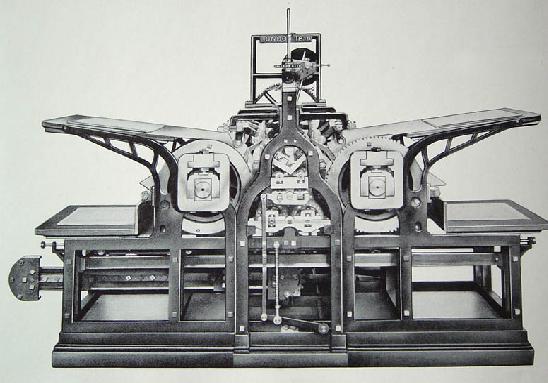|
"Our Journal of this day presents to the Public the practical result of the greatest improvement connected with printing since the discovery of the art itself. The reader of this paragraph now holds in his hand one of the many thousand impressions of The Times newspaper which were taken off last night by a mechanical apparatus. A system of machinery almost organic has been devised and arranged, which, while it relieves the human frame of its most laborious' efforts in printing, far exceeds all human powers in rapidity and dispatch. That the magnitude of the invention may be justly appreciated by its effects, we shall inform the public, that after the letters are placed by the compositors, and enclosed in what is called the forme, little more remains for man to do than to attend upon and to watch this unconscious agent in its operations. The machine is then merely supplied with paper: itself places the forme, inks it, adjusts the paper to the forme newly inked, stamps the sheet, and gives it forth to the hands of the attendant, at the same time withdrawing the form for a fresh coat of ink, which itself again distributes, to meet the ensuing sheet now advancing for impression; and the whole of these complicated acts is performed with such a velocity and simultaneousness of movement, that no less than 1100 sheets are impressed in one hour.
"That the completion of an invention of this kind, not the effect of chance, but the result of mechanical combinations methodically arranged in the mind of the artist, should be attended with many obstructions and much delay, may be readily imagined. Our share in this event has, indeed, only been the application of the discovery, under an arrangement with the patentees, to our own particular business; yet few can conceive - even with this limited interest - the various disappointments and deep anxiety for which we have for a long course of time been subjected.
"Of the person who made this discovery we have but little to add.
"Sir Christopher Wren's noblest monument is to be found in the building which he erected; so is the best tribute of praise which we are capable of offering to the inventor of the printing machine, comprised in the preceding description, which we have feebly sketched, of the powers and utility of his invention. It must suffice to say further, that he is a Saxon by birth; that his name is Koenig; and that the invention has been executed under the direction of his friend and countryman, Bauer."
|
|

